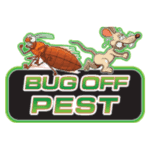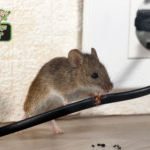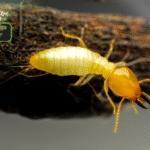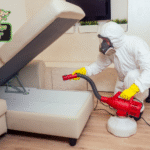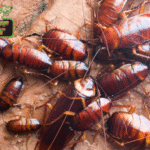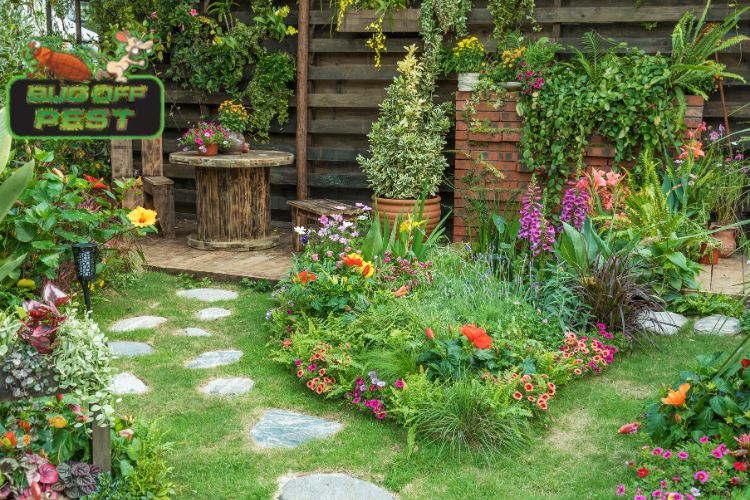You work hard to cultivate a beautiful garden and keep your houseplants thriving. When pests invade, your first instinct is to protect your property. This often raises a critical question: is pest control harmful to your plants? While the primary goal of any treatment is to eliminate pests, some methods can pose a risk to your cherished plant life. Understanding how different pest control options affect your greenery is the first step toward managing infestations without sacrificing your healthy plants.
Pest control involves the use of various materials—whether organic, natural, or synthetic—to manage, repel, or eliminate a wide range of pests. The fundamental purpose is to protect your home and property, including your plants, from the damage that infestations can cause. When you face pest problems, the right approach can preserve the health and beauty of your landscape.
However, can pest control methods damage your plants? Yes, while a professional pest control company aims to protect your property, some treatments carry a risk of harm to plant life, especially if not applied correctly. Understanding this risk is key to balancing the need to control garden pests with the desire to maintain healthy plants.
Why Gardens and Plants Need Pest Control
For anyone with a green thumb, dealing with garden pests is an unavoidable reality. These unwanted visitors can undo months of hard work in a short amount of time, making pest control essential for maintaining a vibrant garden. Insects and other pests are not just a nuisance; they can cause significant and varied damage to your plant life.
Different pests target different parts of a plant. Some, like vine weevils, attack the roots, cutting off the plant’s nutrient supply and causing it to die. Others, such as aphids and caterpillars, feed on leaves and stems, leading to discoloration, distortion, and decay. Many pests also act as vectors, spreading diseases from one plant to another, which can quickly devastate an entire garden.
Without effective pest control, these pest problems can escalate, preventing you from growing healthy plants. While some chemical treatments can be harsh, there are pest control treatments that are safe for plants when applied correctly. These methods help you manage destructive garden pests and protect your investment in your landscape.
Common Types of Plant Pests
Your garden is an ecosystem that can attract numerous types of pests, each with its own destructive habits. Knowing which garden pests you are up against is crucial for effective control. These insects can cause a range of issues, from minor cosmetic damage to complete plant death, which is why pest control is sometimes necessary.
Certain pests are notorious for the havoc they wreak. Aphids, for example, suck the sap from plants, causing distortion and decay, while their sticky “honeydew” attracts other pests like ants. Slugs and caterpillars are voracious eaters that can chew irregular holes in leaves, destroying foliage overnight.
Here are a few common garden pests to watch for:
Aphids: These tiny, soft-bodied insects feed on plant sap, causing leaves to curl and distort.
Beetles: Pests like the Japanese beetle and vine weevil attack both leaves and roots.
Slugs: These pests create smooth, irregular holes in leaves and are especially fond of succulent plants and seedlings.
Caterpillars: As the larval stage of moths and butterflies, they can consume large amounts of foliage quickly.
Different Types of Pest Control Methods
When it comes to managing pests, there isn’t a single solution that fits every situation. Pest control methods range from synthetic chemical applications to natural and organic alternatives. Each type of pesticide is designed to target specific pests, and understanding the differences is key to protecting your plants.
Professional commercial pest control services often use an integrated approach, selecting the best method based on the type of pest, the extent of the infestation, and the surrounding environment. Are there pest control treatments that are safe for plants? Yes, many options are designed to minimize harm, but their safety depends on proper application. Let’s explore how different methods work.
Chemical Pest Control: How It Works
Chemical pest control uses specially formulated products to eliminate or control pest populations. The term “pesticide” is broad and covers many different substances, each with a specific target. For instance, an insecticide is formulated to kill insects, while a rodenticide targets rodents. Understanding these distinctions is vital for safe pesticide use.
One of the most important distinctions for plant safety is between an insecticide and an herbicide. Herbicides are a type of chemical pesticide specifically created to kill unwanted plants and weeds. If an herbicide is accidentally applied to or drifts onto your garden plants, it will cause significant damage or death. This is one of the primary ways chemicals can injure plants.
Even an insecticide can sometimes harm plants. How do insecticides sometimes injure plants? This often happens through improper application, using a concentration that is too high, or applying it to a plant that is particularly sensitive to the formula’s ingredients. These dangerous chemicals can “burn” the leaves or disrupt the plant’s normal functions if not used with caution.
Organic and Natural Pest Control Alternatives
For those wary of synthetic chemicals, organic and natural pest control methods offer a compelling alternative. These approaches use substances derived from natural sources or leverage ecological principles to manage pests, making them a popular choice for gardeners seeking an environmentally friendly solution.
Are natural or organic pest control options safer for plants? Generally, yes. Organic pesticides tend to be less harsh and break down more quickly in the environment. Methods like introducing beneficial insects, such as ladybugs to eat aphids, create a natural balance in your garden. However, “natural” does not mean completely harmless. Products like insecticidal soaps and horticultural oils can still damage plants if over-applied or used in direct, hot sunlight.
Common organic and natural options include:
Neem Oil Sprays: A vegetable oil pressed from the fruits and seeds of the neem tree that disrupts pest hormones.
Insecticidal Soaps: Specially formulated soaps that break down the outer shell of soft-bodied insects.
Beneficial Insects: Introducing predators like lacewings or parasitic wasps to control pest populations naturally.
Effects of Pest Control on Plant Health
While pest control is designed to protect your property, it’s important to recognize that it can sometimes have unintended consequences on plant health. Do pest control products affect plant growth or health? The answer is yes, they can. The application of certain chemicals, even when done with care, can lead to plant damage that affects the plant’s immediate appearance and long-term vitality.
The impact on plant life can range from minor cosmetic issues to severe stress that hinders growth and productivity. Understanding these potential effects allows you to take preventive measures and identify problems early. The following sections will cover both the immediate and long-term influence of pest control on your plants.
Immediate Impact on Leaves, Roots, and Stems
When a plant has a negative reaction to a pest control treatment, the signs are often visible almost immediately. This acute plant damage typically appears on the most exposed parts, such as the leaves, but can also affect the stems and, indirectly, the roots. These symptoms are a clear signal that the treatment has harmed the plant’s tissues.
What signs show that pest control has harmed a plant? You might notice “burning” on the leaves, where parts of the foliage appear scorched or dried out. Other immediate signs include the appearance of specks, flecks, or dead spots on the leaves. The leaf tips and outer edges might also start to die off, indicating a toxic reaction.
This kind of damage disrupts the plant’s ability to photosynthesize and transport nutrients, which is essential for survival. While a strong plant might recover, this initial shock can weaken it, making it more vulnerable to other stressors. Recognizing these signs quickly is the first step toward helping your plant recover and return to being one of your healthy plants.
Long-Term Influence on Growth and Productivity
Beyond the immediate signs of harm, pest control products can have a lasting influence on plant life. These long-term effects are often more subtle but can significantly impact a plant’s overall growth and productivity. If chemicals accumulate in the soil, they can damage the delicate root system, hindering the plant’s ability to absorb water and nutrients.
This disruption can lead to several chronic issues. For example, you may observe that seed germination is delayed or that seedlings fail to thrive and die off. Established plants might exhibit stunted growth, never reaching their full size or potential. This directly affects productivity, meaning flowering plants may produce fewer blooms and vegetable plants may yield a smaller harvest.
Ultimately, any chemical that negatively impacts the soil or the plant’s internal systems will compromise its ability to grow into one of the healthy plants you desire. This is why careful, targeted pesticide use is so crucial for the long-term health of your garden.
Recognizing Damage from Pest Control Treatments
While professional pest control services take every precaution, the risk of damage to plants is never zero. As a homeowner, being able to recognize the warning signs of a negative reaction is your best defense. Knowing what to look for allows you to act quickly and potentially save a plant that has been accidentally harmed.
What signs show that pest control has harmed a plant? The symptoms can manifest as physical changes to the leaves and stems or as alterations in the plant’s overall behavior and appearance. The next sections will detail these specific indicators so you can confidently identify plant damage from pest control treatments.
Physical Signs of Harm in Plants
One of the most direct ways to identify plant damage is by observing its physical signs. These symptoms are often the result of phytotoxicity, which is a toxic reaction in a plant caused by exposure to a chemical compound. This reaction can occur even when a pesticide is applied correctly if a plant is particularly sensitive.
These physical signs are the plant’s way of showing it is under stress. The most common indicators appear on the foliage, as leaves are often the first point of contact with a spray. Look closely for any unusual markings or textures that were not there before the treatment.
Here are some key physical signs of phytotoxicity to watch for:
Dead Spots: You may see specks, flecks, or larger dead spots on the leaves, sometimes between the veins.
Burned Appearance: Leaves may look discolored, curled up, or scorched, especially at the tips and margins.
Distortion: The entire plant, including its leaves and roots, may appear twisted or malformed.
Discoloration: Leaves may turn yellow, brown, or develop an unnatural pattern.
Changes in Plant Behavior and Appearance
In addition to direct physical marks, harm from pest control can manifest in a plant’s overall behavior and appearance. These changes might develop more slowly but are serious indicators of a problem. One of the earliest signs can be poor or delayed germination of seeds, or you may notice that young seedlings suddenly die.
A common change in plant behavior is stunted growth. If a plant seems to stop growing or is developing much more slowly than expected after a treatment, it could be a sign of a toxic reaction. Another tell-tale sign is when a plant begins to drop its leaves for no apparent reason. This indicates the plant is under severe stress and is trying to conserve resources.
Furthermore, some chemical pesticides can impact the broader ecosystem around the plant. They can harm the health of the soil by killing beneficial microorganisms or linger in the environment, deterring important pollinators like bees. A lack of pollinators will reduce fruit and seed production, affecting the plant’s reproductive cycle.
How Insecticides and Chemicals Can Cause Injury
You may wonder how a product designed to kill insects can end up harming a plant. The primary mechanism behind this type of injury is a phenomenon called phytotoxicity. This occurs when a chemical pesticide, including an insecticide, has a toxic effect on plant tissues, leading to visible damage.
How do insecticides sometimes injure plants? This can happen for several reasons. The product may be applied at a concentration that is too strong, it could be used on a plant species that is naturally sensitive to its ingredients, or environmental factors like high heat can increase the risk of a toxic reaction. Understanding phytotoxicity is key to preventing it.
Phytotoxicity Explained
Phytotoxicity is the term for the damage or death of a plant resulting from contact with a chemical. Any pesticide, from insecticides to fungicides and especially herbicides, can cause this reaction. It disrupts a plant’s normal physiological processes, leading to symptoms like stunted growth, delayed seed germination, and visible “burns” on the leaves.
The risk of damage from phytotoxicity is highest when pesticides are misused. For example, applying more product than the label recommends or spraying during the hottest part of the day can concentrate the chemicals and increase the chance of harming the plant. It can also occur when spray drifts from a target area to a non-target plant that is more sensitive.
Why Some Chemicals Target Pests Only
Many modern insecticides are designed with a high degree of selectivity, meaning they are formulated to affect pests without harming plants. Why do some pesticides only target insects without hurting plants? This is possible because insects and plants have vastly different biological systems. These chemicals are created to interfere with a process that is unique to insects.
For example, some insecticide formulas work by disrupting an insect’s nervous system, while others interfere with its ability to grow or reproduce. Since plants do not have nervous systems and grow in a completely different way, they are unaffected by these specific chemical actions. This allows for the targeted elimination of pests.
However, it’s important to remember that this selectivity is not always perfect. Some broad-spectrum pesticides can still harm non-target species, including beneficial insects like bees and ladybugs, which are vital for a healthy garden ecosystem. This is why choosing the right pesticide and application method is so important.
Safe Application of Pest Control Around Plants
The key to protecting your plants during pest control is safe and knowledgeable application. While there is always some risk of damage, following best practices can dramatically reduce the chances of harming your garden. How can I apply pest control without harming my plants? The simplest and most effective way is to rely on professionals.
Professional pest control services have the training and experience to evaluate your property, identify sensitive plants, and choose the right products. They understand how factors like wind and weather can affect an application and take precautions to protect your landscape. The next sections outline some of these essential safety measures.
Best Practices for Minimizing Risk
Whether you’re attempting a DIY solution or working with a professional, following certain best practices is crucial for minimizing the risk of damage to your plants. A careful, considered approach ensures that the treatment targets pests, not your prized petunias or vegetable garden. For specialized services like Termite Treatment, these practices are even more critical.
The single most important rule is to always read and follow the directions on the product label. The label provides vital information on what plants the product is safe for, the correct mixing ratios, and when to apply it. Taking shortcuts or assuming “more is better” is a common cause of plant damage. Adhering to these guidelines is one of the best ways to protect your property.
Here are some additional best practices for safe pest control:
Hire a Professional: A company providing Pest Control in Port Charlotte will inspect your property and choose the safest, most effective treatment.
Avoid Windy or Rainy Days: Apply treatments on calm days to prevent the chemicals from drifting onto sensitive plants.
Protect Pollinators: Inform your pest control provider if you need to protect pollinators so they can adjust their methods.
Test a Small Area: If you’re unsure, test the product on a small, inconspicuous part of the plant and wait 48 hours to check for a reaction.
Steps to Take If Plant Damage Occurs
Even with precautions, accidents can happen. If you notice signs of plant damage after a pest control application, acting quickly can make a big difference in whether the plant recovers. What should I do if pest control has damaged my plants? The first step is to prevent any further exposure to the chemical.
Immediately and gently rinse the plant’s leaves and stems with clean water from a hose. This can help wash off any residual chemicals before they are fully absorbed or cause more harm. Be careful not to blast the plant with high pressure, as this could cause additional physical damage to its already stressed tissues.
After rinsing, prune away any severely burned or damaged leaves. This allows the plant to direct its energy toward new, healthy growth instead of trying to repair tissues that cannot be saved. Provide supportive care by ensuring the plant is properly watered, but avoid applying any fertilizer until it shows clear signs of recovery. This will give it the best chance to bounce back and become one of your healthy plants again.
Check the related blog: Are Quarterly Pest Control Plans Worth It in Port Charlotte?
Frequently Asked Questions
Yes, pest control products can cause plant damage and even kill houseplants, especially if the wrong chemical pesticide is used or applied incorrectly. Over-the-counter sprays can cause “burning” or phytotoxicity. Always use a pesticide labeled as safe for indoor houseplants and follow all instructions to avoid harming them.
Generally, organic pest control methods are safer for healthy plants and beneficial insects when compared to synthetic chemicals. However, even organic pesticides like horticultural oils and insecticidal soaps can cause damage if misapplied. It’s always best to test on a small area first to solve your pest problems safely.
If you suspect plant damage from an insecticide, immediately rinse the plant with clean water. Prune any severely damaged leaves to help the plant focus its energy on new growth. Avoid fertilizing until it recovers, and continue to provide proper water to help it return to being a healthy plant.
